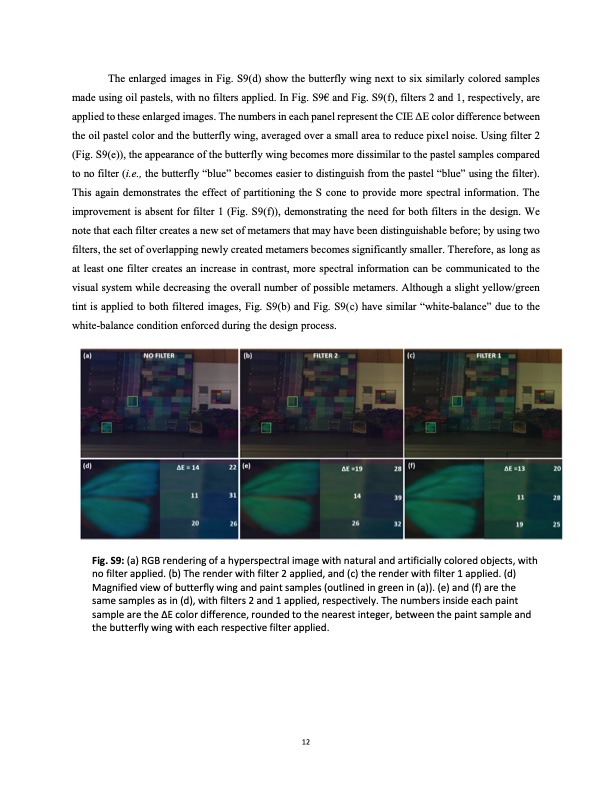
PDF Publication Title:
Text from PDF Page: 032
The enlarged images in Fig. S9(d) show the butterfly wing next to six similarly colored samples made using oil pastels, with no filters applied. In Fig. S9€ and Fig. S9(f), filters 2 and 1, respectively, are applied to these enlarged images. The numbers in each panel represent the CIE ΔE color difference between the oil pastel color and the butterfly wing, averaged over a small area to reduce pixel noise. Using filter 2 (Fig. S9(e)), the appearance of the butterfly wing becomes more dissimilar to the pastel samples compared to no filter (i.e., the butterfly “blue” becomes easier to distinguish from the pastel “blue” using the filter). This again demonstrates the effect of partitioning the S cone to provide more spectral information. The improvement is absent for filter 1 (Fig. S9(f)), demonstrating the need for both filters in the design. We note that each filter creates a new set of metamers that may have been distinguishable before; by using two filters, the set of overlapping newly created metamers becomes significantly smaller. Therefore, as long as at least one filter creates an increase in contrast, more spectral information can be communicated to the visual system while decreasing the overall number of possible metamers. Although a slight yellow/green tint is applied to both filtered images, Fig. S9(b) and Fig. S9(c) have similar “white-balance” due to the white-balance condition enforced during the design process. Fig. S9: (a) RGB rendering of a hyperspectral image with natural and artificially colored objects, with no filter applied. (b) The render with filter 2 applied, and (c) the render with filter 1 applied. (d) Magnified view of butterfly wing and paint samples (outlined in green in (a)). (e) and (f) are the same samples as in (d), with filters 2 and 1 applied, respectively. The numbers inside each paint sample are the ΔE color difference, rounded to the nearest integer, between the paint sample and the butterfly wing with each respective filter applied. 12PDF Image | Enhancing color vision by breaking binocular redundancy

PDF Search Title:
Enhancing color vision by breaking binocular redundancyOriginal File Name Searched:
enhancing-human-color-vision-670-nm.pdfDIY PDF Search: Google It | Yahoo | Bing
Cruise Ship Reviews | Luxury Resort | Jet | Yacht | and Travel Tech More Info
Cruising Review Topics and Articles More Info
Software based on Filemaker for the travel industry More Info
The Burgenstock Resort: Reviews on CruisingReview website... More Info
Resort Reviews: World Class resorts... More Info
The Riffelalp Resort: Reviews on CruisingReview website... More Info
| CONTACT TEL: 608-238-6001 Email: greg@cruisingreview.com | RSS | AMP |